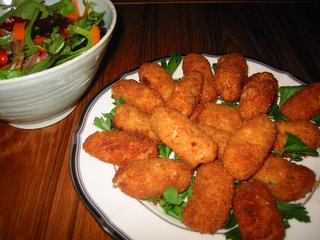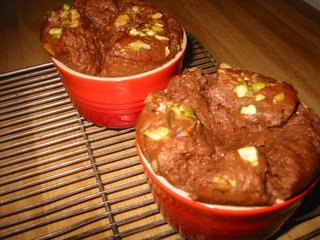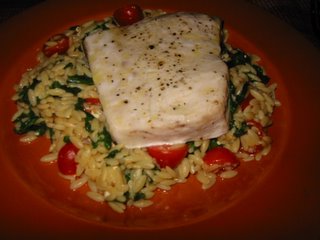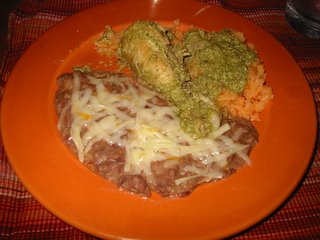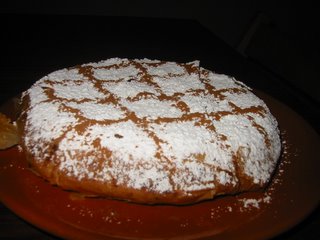
B'stilla is a Moroccan savory-sweet chicken pie. It was once made with pigeon, and my husband claims it as a dish that originated in his hometown of Fes. It is a dish fit for royalty-- crisp layers of phyllo dough, savory chicken slow-cooked in broth and spices and shredded, and a crunchy layer of toasted and ground almonds, cinnamon, and sugar.
In one of the classes I teach about the Middle East, my students wanted to do a potluck supper/movie watching session. Understandably for a class involving food, it was one of the most successful classes all term. The students went all out-- they made feta cheese dip, Middle Eastern carrot cake, tabbouleh, cauliflower-potato curry, hummus and chips, and one student brought samosas and a huge box of baklava. (Not all the dishes were strictly Middle Eastern, but that didn't matter much). We stuffed ourselves and watched a Tunisian film, "A Summer in La Goulette."
For my contribution, I spent the entire evening before making a vegetarian harira (spicy lentil soup) and this chicken b'stilla. I started out following Mark Bittman's version in
The Best Recipes in the World
, but aside from following the quantities I abandoned much of his technique, since it was different from what my in-laws do. Nour helped me put it all together, because phyllo isn't the easiest thing to work with.
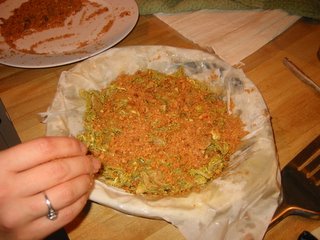 B'stilla
B'stilla2 Tblsp. canola oil
2 minced garlic cloves
1 finely chopped onion
2 lbs. boneless, skinless thighs (although you can use regular thighs and just de-bone them after they cook-- then use maybe 3 pounds)
1/4 cup finely chopped parsley
1/4 cup finely chopped cilantro
1 tsp. ground turmeric
1 tsp. ginger
3 cups chicken stock
4 eggs, lightly beaten
1/2 cup skinless almonds
2 tsp. ground cinnamon
1-2 Tblsp. sugar
1/2 pound phyllo (12 sheets)
8 Tblsp. (1 stick) melted butter
Confectioner's sugar
Defrost your phyllo dough. Read the box instructions for how to do this.
Heat oil in a large saucepan over medium. Cook garlic and onion until soft, about 3 minutes. Add chicken, parsley, turmeric, saffron, ginger, and stock. Season with salt and pepper, bring to a boil, then cover and simmer 20 minutes. Remove chicken from the pot to cool.
While stirring the stock, pour the eggs in slowly. (They will cook, but if you keep stirring they stay pretty separate, which is what you want). Simmer the stock, uncovered, until reduced by half (about 10 minutes). Shred chicken and return to stock, keep simmering until there is no more liquid. Remove from heat.
Here's where Bittman and I part ways. Toast the almonds in hot oil until they turn golden brown, remove to paper towels to drain. Grind in a coffee grinder but leave some chunky almond bits for consistency. Mix with cinnamon and regular sugar. Try one tablespoon first and taste. If you like it sweeter, add another tablespoon.
Preheat your oven to 425.
Get out the phyllo dough, making sure you followed the box instructions for defrosting, otherwise it will crack easily. Unroll phyllo dough carefully and have a damp towel ready to place on top. In a 9" pie pan using a pastry brush, brush butter on the bottom and sides of the pan. Place one sheet of phyllo dough in the pan, brush quickly with a little butter, place another on top, brush again, etc. Dough will be hanging over the sides, brush the sides too. Do 4-5 sheets this way. Cover the extra dough with cloth. Then add the chicken mixture. Cover chicken with the almond-sugar mixture (see photo). Fold the dough layers that were hanging over the side over the top and add a few more sheets, each brushed with butter, if you like. You may have extra butter or dough left at the end. An egg yolk brushed over the top is also optional. Bake 20-30 minutes, keeping an eye on the pie to see when it turns golden brown.
Remove from pan if you like, or if you're concerned about keeping it in one piece, leave it in there. When finished, sift a generous layer of powdered sugar over the top. Tap out cinnamon in a criss-cross pattern, as shown. Slice it up and enjoy. It's very elaborate but it's my favorite Moroccan dish-- very unusual and complex, served generally as a first course at weddings. My students loved it. Colleagues who tried a piece said they'd never tasted anything like it.
Another big success at the potluck class session was the
Feta cheese dip some of my students made. I believe the source might be Middle East food expert Claudia Roden. Take 1/2 pound feta, the juice of one lemon, 2 Tblsp. vegetable oil, and 1 Tblsp. olive oil. Mash the feta with everything else using a fork until smooth. I asked for the recipe and will definitely make this dip again as well.
Tasting your way into another culture is one of the best ways to experience it.

